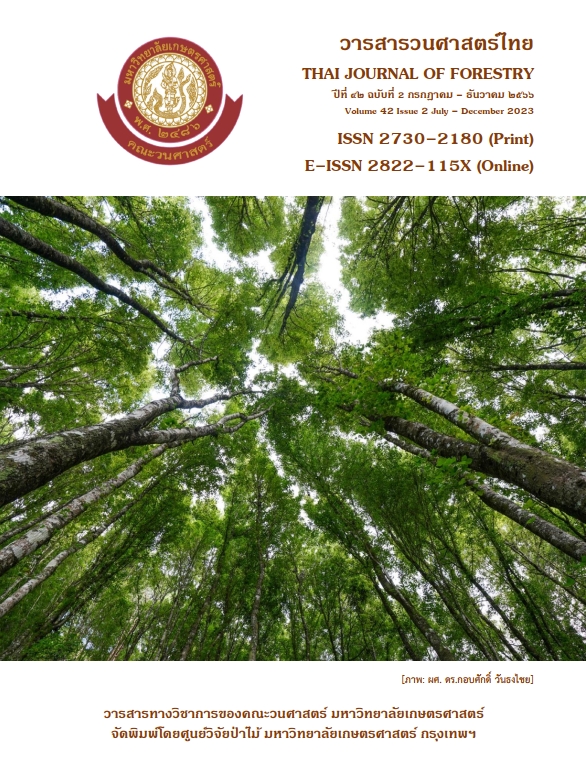กำลังผลิตสำรองและการกักเก็บคาร์บอนของไผ่ในป่าชุมชนบ้านแป้นโป่งชัย เปรียบเทียบกับปริมาณความต้องการใช้ประโยชน์ของชุมชน
Main Article Content
บทคัดย่อ
การศึกษามีวัตถุประสงค์เพื่อศึกษาสภาพเศรษฐกิจและสังคมของชุมชน ลักษณะทางนิเวศของป่า การเจริญเติบโต ผลผลิต และการกักเก็บคาร์บอนของไผ่ในป่าชุมชนบ้านแป้นโป่งชัย โดยการสัมภาษณ์ประชากรกลุ่มเป้าหมาย ที่ใช้ประโยชน์จากไม้ไผ่ร่วมกับการสำรวจป่า โดยการสุ่มแบบแบ่งชั้นภูมิตามความหนาแน่นของหมู่ไม้ 3 ระดับ คือ สูง ปานกลาง ต่ำ ด้วยการวางแปลงตัวอย่างถาวร ขนาด 40x40 ตารางเมตร ทั้งหมด 6 แปลง กระจายตามชั้นภูมิละ 2 แปลง คิดเป็นร้อยละการสำรวจเท่ากับ 1.57
ผลการศึกษา พบว่า ลักษณะสังคมพืชเป็นป่าเบญจพรรณ มีชนิดไม้เด่น 5 ชนิดแรก ได้แก่ มะกอกเกลื้อน ประดู่ป่า แดง เต็ง และ รัง ตามลำดับ และ ในป่าชุมชนพบไผ่ 5 ชนิด ได้แก่ ไผ่ซาง ไผ่ไร่ ไผ่ไร่เรียบ ไผ่ข้าวหลาม และ ไผ่บง ตามลำดับ คิดเป็น 32.36 กอ/ไร่ (202.25 ลำ/เฮกตาร์ และ 477.92 ลำ/ไร่ (4,251.06 ลำ/เฮกตาร์) โดยพบไผ่ซางมากที่สุด ปริมาณมวลชีวภาพและการกักเก็บคาร์บอนของหมู่ไม้เท่ากับ 8.25 ตันต่อไร่ (51.56 ตัน/เฮกตาร์) และ 12.87 ตันคาร์บอนไดออกไซด์เทียบเท่า/ไร่ (80.44 ตันคาร์บอนไดออกไซด์เทียบเท่า/เฮกตาร์) ส่วนปริมาณมวลชีวภาพและการกักเก็บคาร์บอนของไผ่เท่ากับ 24.38 ตัน/ไร่ (152.38 ตัน/เฮกตาร์) และ 42.01 ตันคาร์บอนไดออกไซด์เทียบเท่า/ไร่ ตามลำดับ และชุมชนมีการใช้ประโยชน์ไผ่ 4 รูปแบบ ได้แก่ การเกษตร จักสาน ไม้กวาด และ เบ็ดเตล็ด เป็นปริมาณเฉลี่ยเท่ากับ 67,172.00, 10,758.00, 9,970.40 และ 5,697.00 ลำต่อปี ตามลำดับ โดยราษฎรกลุ่มเป้าหมายส่วนใหญ่ประกอบอาชีพค้าขาย มีรายได้และรายจ่ายเฉลี่ยระหว่าง 75,001–150,000 บาทต่อครัวเรือนต่อปี มีหนี้สินร้อยละ 50 และแหล่งเงินกู้ที่สำคัญได้แก่ ธนาคารเพื่อการเกษตรและสหกรณ์การเกษตร
Downloads
Article Details

อนุญาตภายใต้เงื่อนไข Creative Commons Attribution-NonCommercial-NoDerivatives 4.0 International License.
ข้าพเจ้าและผู้เขียนร่วม (ถ้ามี) ขอรับรองว่า ต้นฉบับที่เสนอมานี้ยังไม่เคยได้รับการตีพิมพ์และไม่ได้อยู่ในระหว่างกระบวนการพิจารณาตีพิมพ์ลงในวารสารหรือสิ่งตีพิมพ์อื่นใด ข้าพเจ้าและผู้เขียนร่วม (ถ้ามี) ยอมรับหลักเกณฑ์และเงื่อนไขการพิจารณาต้นฉบับ ทั้งยินยอมให้กองบรรณาธิการมีสิทธิ์พิจารณาและตรวจแก้ต้นฉบับได้ตามที่เห็นสมควร พร้อมนี้ขอมอบลิขสิทธิ์ผลงานที่ได้รับการตีพิมพ์ให้แก่วารสารวนศาสตร์ คณะวนศาสตร์ มหาวิทยาลัยเกษตรศาสตร์ กรณีมีการฟ้องร้องเรื่องการละเมิดลิขสิทธิ์เกี่ยวกับภาพ กราฟ ข้อความส่วนใดส่วนหนึ่ง หรือ ข้อคิดเห็นที่ปรากฏในผลงาน ให้เป็นความรับผิดชอบของข้าพเจ้าและผู้เขียนร่วม (ถ้ามี) แต่เพียงฝ่ายเดียว และหากข้าพเจ้าและผู้เขียนร่วม (ถ้ามี) ประสงค์ถอนบทความในระหว่างกระบวนการพิจารณาของทางวารสาร ข้าพเจ้าและผู้เขียนร่วม (ถ้ามี) ยินดีรับผิดชอบค่าใช้จ่ายทั้งหมดที่เกิดขึ้นในกระบวนการพิจารณาบทความนั้น”
เอกสารอ้างอิง
Athiratanapanya, V. 1993. Management of Bamboo (Thyrsostachys siamensis) Plantations to Produce Shoots and Stems. M.S. Thesis, Kasetsart University, Bangkok, Thailand. (in Thai)
IPCC. 2006. IPCC Guidelines for National Greenhouse Gas Inventories. The National Greenhouse Gas Inventories Programme. IGES, Japan.
Khamai, S. 2006. Demand for Bamboo Used as Raw Material for Cottage Industry of Tum Chalong Sub-district, Muang District, Uttaradit Province. M.S. Thesis, Kasetsart University, Bangkok, Thailand. (in Thai)
Kutintara, U., Marod, D., Takahashi, M., Nakashizuka, T. 1995. Growth and Dynamics of Bamboos in a Tropical Seasonal Forest. Japan Science and Technology Agency, National Research Council of Thailand, Japan International Science and Technology Exchange Center, Bangkok, Thailand. (in Thai)
Ministry of Natural Resources and Environment. 2009. Biodiversity Encyclopedia of Bansa, Chae Hom District, Lampang Province. Tone Colour: The Press Studio, Chiang Mai, Thailand. (in Thai)
Office of Natural Resources and Environmental Policy and Planning. 2022. Green Network. https://www.greennetworkthailand.com/co2-energy-q2-2565/, 19 October 2022.
Ogawa, H., Yoda, K., Kira, T. 1965. A preliminary survey on the vegetation of Thailand. Nature and Life in SE Asia, 1: 21-157.
Royampaeng, S. 1990. Biomass Production of 4 Indigenous Bamboo Species Planted at Ang-khang Royal Project, Chiang Mai Province. Faculty of Forestry, Kasetsart University, Bangkok, Thailand. (in Thai)
Shannon, C.E., Weiner, W. 1949. The Mathematical Theory of Communication. University of Illinois Press, Urbana, Illinois, USA.
Subanseni, V. 1996. Non–Timber Forest Products in Thailand. Royal Forest Department, Bangkok, Thailand. (in Thai)
Thanakitrungreung, A., Ohm-apinyan, S., Tiyanon, P., Kothamah, S. 1990. Inventory and utilization of bamboos in Ngao district Lampang province. Thai Journal of Forestry, 9(1): 36-47. (in Thai)
Wanalanka, I., Poolsiri, R., Puangchit, L. 2015. Aboveground biomass of 4 bamboo plantations in different culm ages at Royal Agricultural Station Angkhang, Chiang Mai province. Thai Journal of Forestry, 34(1): 65-75. (in Thai)


